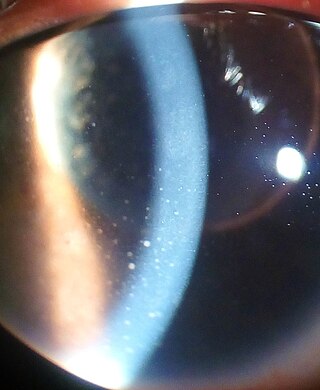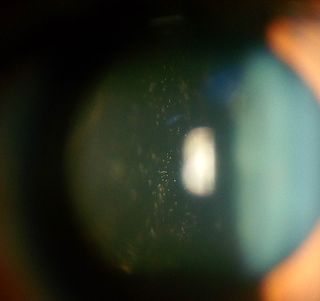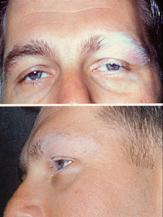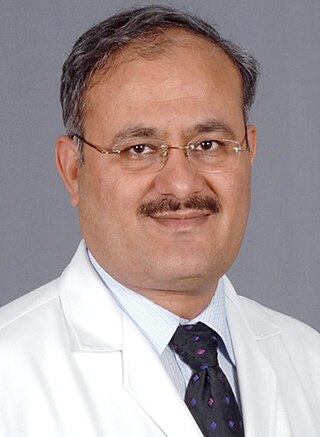
Ophthalmology is a clinical and surgical specialty within medicine that deals with the diagnosis and treatment of eye disorders. A former term is oculism.
The National Eye Institute (NEI) is part of the U.S. National Institutes of Health (NIH), an agency of the U.S. Department of Health and Human Services. The mission of NEI is "to eliminate vision loss and improve quality of life through vision research." NEI consists of two major branches for research: an extramural branch that funds studies outside NIH and an intramural branch that funds research on the NIH campus in Bethesda, Maryland. Most of the NEI budget funds extramural research.

Uveitis is inflammation of the uvea, the pigmented layer of the eye between the inner retina and the outer fibrous layer composed of the sclera and cornea. The uvea consists of the middle layer of pigmented vascular structures of the eye and includes the iris, ciliary body, and choroid. Uveitis is described anatomically, by the part of the eye affected, as anterior, intermediate or posterior, or panuveitic if all parts are involved. Anterior uveitis (iridocyclitis) is the most common, with the incidence of uveitis overall affecting approximately 1:4500, most commonly those between the ages of 20-60. Symptoms include eye pain, eye redness, floaters and blurred vision, and ophthalmic examination may show dilated ciliary blood vessels and the presence of cells in the anterior chamber. Uveitis may arise spontaneously, have a genetic component, or be associated with an autoimmune disease or infection. While the eye is a relatively protected environment, its immune mechanisms may be overcome resulting in inflammation and tissue destruction associated with T-cell activation.

Cytomegalovirus retinitis, also known as CMV retinitis, is an inflammation of the retina of the eye that can lead to blindness. Caused by human cytomegalovirus, it occurs predominantly in people whose immune system has been compromised, 15-40% of those with AIDS.
Sympathetic ophthalmia (SO), also called spared eye injury, is a diffuse granulomatous inflammation of the uveal layer of both eyes following trauma to one eye. It can leave the affected person completely blind. Symptoms may develop from days to several years after a penetrating eye injury. It typically results from a delayed hypersensitivity reaction.

Ectopia lentis is a displacement or malposition of the eye's crystalline lens from its normal location. A partial dislocation of a lens is termed lens subluxation or subluxated lens; a complete dislocation of a lens is termed lens luxation or luxated lens.

Massachusetts Eye and Ear is a specialty hospital located in Boston, Massachusetts, United States, which focuses on ophthalmology (eye), otolaryngology (ear/nose/throat), and related medicine and research. Founded in 1824 as the Boston Eye Infirmary (BEI), it has also been known as the Massachusetts Charitable Eye and Ear Infirmary (MCEEI), and Massachusetts Eye and Ear Infirmary (MEEI). It is a teaching partner of Harvard Medical School.

Difluprednate, sold under the brand name Durezol, is a corticosteroid used for the treatment of post-operative ocular inflammation and pain.

Presumed ocular histoplasmosis syndrome (POHS) is a syndrome affecting the eye, which is characterized by peripheral atrophic chorioretinal scars, atrophy or scarring adjacent to the optic disc and maculopathy.

Intermediate uveitis is a form of uveitis localized to the vitreous and peripheral retina. Primary sites of inflammation include the vitreous of which other such entities as pars planitis, posterior cyclitis, and hyalitis are encompassed. Intermediate uveitis may either be an isolated eye disease or associated with the development of a systemic disease such as multiple sclerosis or sarcoidosis. As such, intermediate uveitis may be the first expression of a systemic condition. Infectious causes of intermediate uveitis include Epstein–Barr virus infection, Lyme disease, HTLV-1 virus infection, cat scratch disease, and hepatitis C.

New York Eye and Ear Infirmary of Mount Sinai (NYEE) is located at East 14th Street and Second Avenue in lower Manhattan, New York City. Founded on August 14, 1820, NYEE is America's first specialty hospital and one of the most prominent in the fields of ophthalmology and otolaryngology in the world, providing primary inpatient and outpatient care in those specialties. Previously affiliated with New York Medical College, as of 2013 it is affiliated with the Icahn School of Medicine at Mount Sinai as a part of the membership in the Mount Sinai Health System.

Ibopamine is a sympathomimetic drug, designed as a prodrug of epinine, used in ophthalmology. It induces mydriasis. It also has been investigated for use in the treatment of congestive heart failure.
Douglas Jabs is an American ophthalmologist and an expert in clinical research in the fields of ophthalmology and uveitis.

Vogt–Koyanagi–Harada disease (VKH) is a multisystem disease of presumed autoimmune cause that affects melanin-pigmented tissues. The most significant manifestation is bilateral, diffuse uveitis, which affects the eyes. VKH may variably also involve the inner ear, with effects on hearing, the skin, and the meninges of the central nervous system.

Virender Singh Sangwan is an Indian ophthalmologist and the Dr. Paul Dubord Chair professor and director of the L. V. Prasad Eye Institute, Hyderabad. Known for his research on limbal stem cells, Sangwan is the founder secretary and an adviser of the Uveitis Society of India. The Council of Scientific and Industrial Research, the apex agency of the Government of India for scientific research, awarded him the Shanti Swarup Bhatnagar Prize for Science and Technology, one of the highest Indian science awards for his contributions to Medical Sciences in 2006.
Santosh Gajanan Honavar is an Indian ophthalmologist and is currently the Honorary General Secretary of the All India Ophthalmological Society; Director of Medical Services ; Director, Department of Ocular Oncology and Oculoplasty at Centre for Sight, Hyderabad; and Director, National Retinoblastoma Foundation. He was the Editor of the Indian Journal of Ophthalmology and Indian Journal of Ophthalmology - Case Reports, the official journals of the All India Ophthalmological Society from 2017 to 2023.

Janine Austin Clayton is an American ophthalmologist. She is the NIH associate director for research on women's health and director of the Office of Women's Health. Clayton was previously the deputy clinical director of the National Eye Institute.

Hatice Nida Sen is an ophthalmologist researching mechanisms involved in different forms of human uveitis. She is a clinical investigator at the National Eye Institute.

Secondary glaucoma is a collection of progressive optic nerve disorders associated with a rise in intraocular pressure (IOP) which results in the loss of vision. In clinical settings, it is defined as the occurrence of IOP above 21 mmHg requiring the prescription of IOP-managing drugs. It can be broadly divided into two subtypes: secondary open-angle glaucoma and secondary angle-closure glaucoma, depending on the closure of the angle between the cornea and the iris. Principal causes of secondary glaucoma include optic nerve trauma or damage, eye disease, surgery, neovascularization, tumours and use of steroid and sulfa drugs. Risk factors for secondary glaucoma include uveitis, cataract surgery and also intraocular tumours. Common treatments are designed according to the type and the underlying causative condition, in addition to the consequent rise in IOP. These include drug therapy, the use of miotics, surgery or laser therapy.

Uveitic glaucoma is most commonly a progression stage of noninfectious anterior uveitis or iritis.















